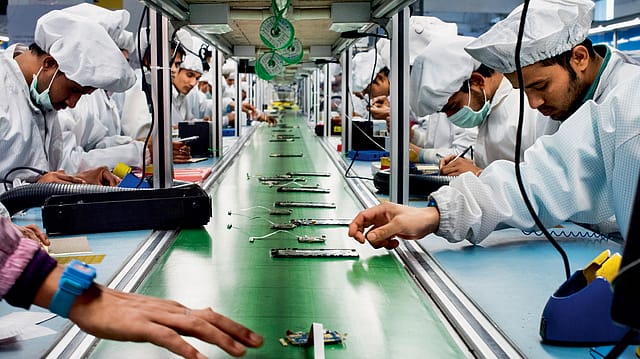India's manufacturing PMI slips to 8-month low
ADVERTISEMENT

India's manufacturing Purchasing Managers' Index (PMI) for October hit the lowest in eight months as demand for certain types of products faded.
The seasonally adjusted S&P Global India Manufacturing Purchasing Managers' Index (PMI) stood at 55.5 in October, down from 57.5 in September, signalling the slowest rate of expansion since February.
The latest PMI reading, however, remains above its long-run average of 53.9. A reading over 50 indicates an overall increase in factory output.
Growth eased to an eight-month low, weighed by competitive pressures and weak demand at some plants. Granular data highlighted a particularly marked slowdown in the consumer goods sub-sector.
Output increased further at the start of the third fiscal quarter, stretching the current sequence of expansion to over two years. "India's manufacturing sector generated substantial growth in October, despite a challenging global economic environment. Still, insights from surveyed purchasing managers pointed to the deceleration of several measures," says Pollyanna De Lima, Economics Associate Director at S&P Global Market Intelligence.
December 2025
The annual Fortune 500 India list, the definitive compendium of corporate performance, is out. This year, the cumulative revenue of the Fortune 500 India companies has breached $2 trillion for the first time. Plus, find out which are the Best B-schools in India.
"The survey's new orders index slipped to a one-year low, as some firms raised concerns about the current demand picture for their products. Consumer goods was behind most of the slowdown, recording considerably softer increases in sales, production, exports, input inventories and buying levels. Growth of all of the aforementioned variables was led by capital goods makers which, with the exception of new orders, registered accelerated rates of expansion," Lima says.
Although a further increase in new orders was a positive development, October data signalled a deceleration in growth since September. The rate of expansion was the softest in a year, with consumer goods especially affected.
With fewer than 4% of companies hiring extra staff and 95% leaving workforce numbers unchanged, the rate of job creation was slight and the slowest since April, the PMI release says.
Price trends were also mixed. Both input costs and output charges increased, but inflation of the former accelerated while factory gate charges rose to a weaker extent. When listing materials that had increased in price, firms mentioned aluminium, chemicals, leather, paper, rubber and steel.
"We saw further indication of broadly stable inflationary forces across the manufacturing industry. It appears that a moderate increase in input costs was simply passed on to clients. Nonetheless, qualitative evidence from the future output question revealed an interesting finding, as reports of rising inflation expectations were expected to dent demand and subsequently production growth over the course of the coming 12 months," says Lima.
Growth of international sales remained historically strong despite losing momentum in October. The rise was the weakest in four months. Those firms that experienced an increase in new orders from abroad reported gains from Asia, Europe, the Middle East and the U.S.
